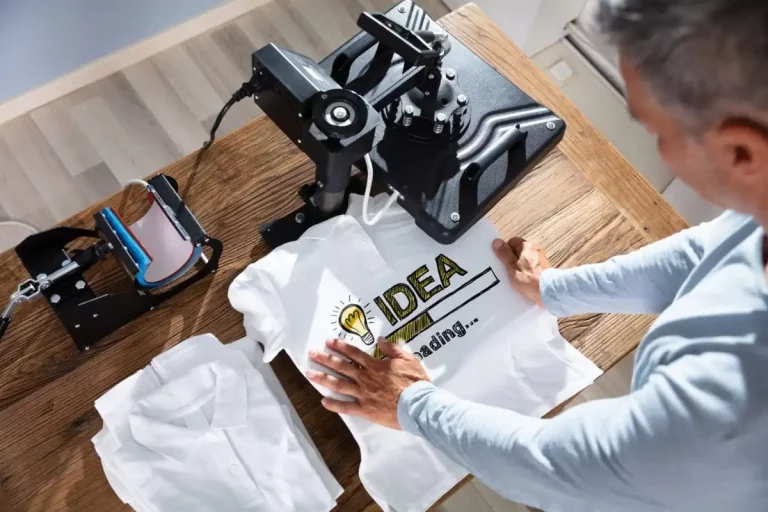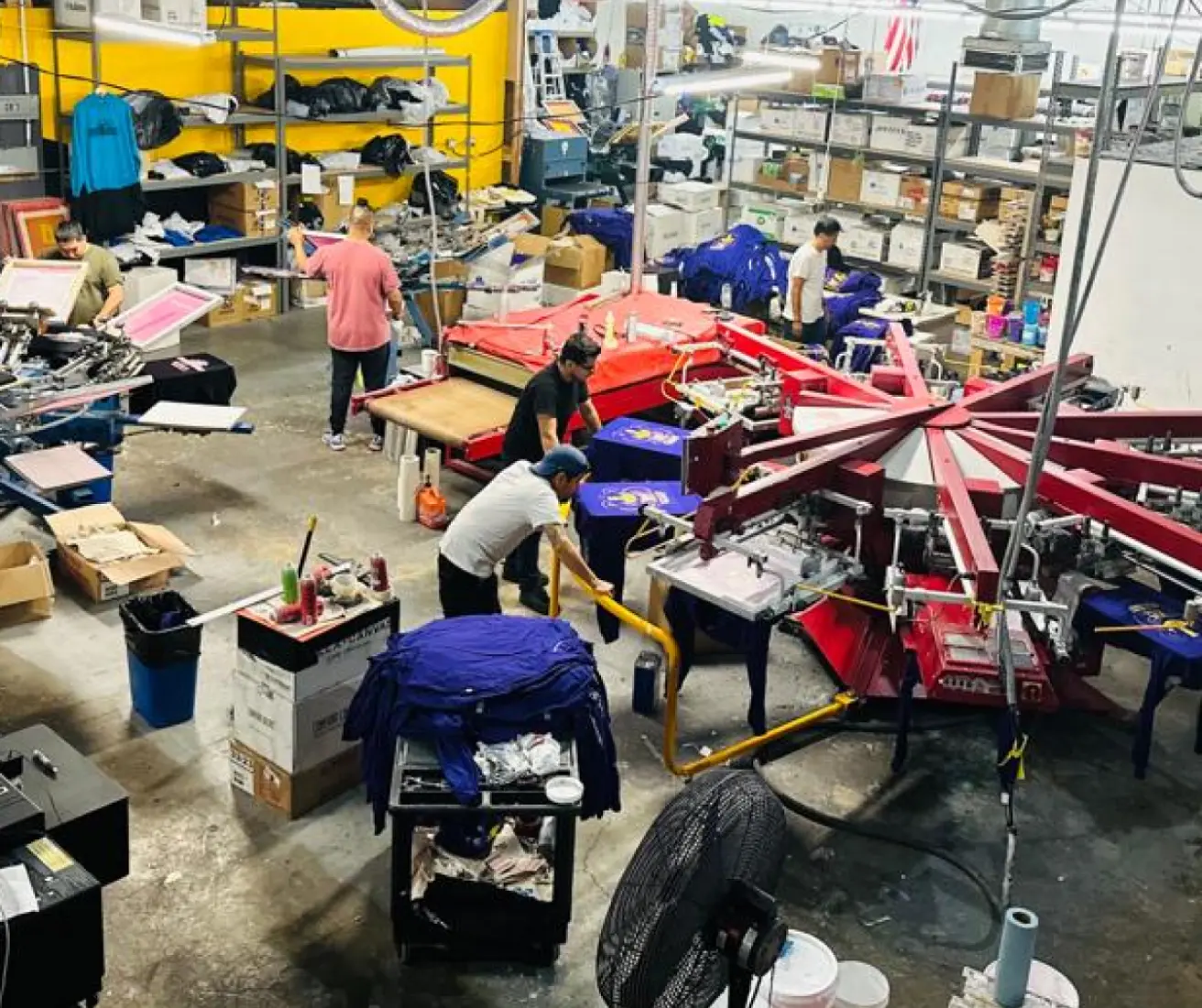Detailed Silk Screen Printing for Custom Art Apparel
Detailed Silk Screen Printing for Custom Art Apparel
Blog Article
Display Printing Uncovered: Whatever You Need to Learn About Tee and Garment Printing Methods
If you've ever asked yourself just how those dynamic layouts wind up on your favored tees, you're in the ideal location. Screen printing is an interesting technique that combines art with strategy, supplying unlimited possibilities for imagination. Comprehending the basics, from tools to ink selections, can greatly affect your results. Prepared to check out the essential elements that make display publishing an art type? Allow's uncover the information that can elevate your projects.
The Essentials of Screen Printing: Exactly How It Functions
When you plunge right into display printing, you'll discover it's both a scientific research and an art. At its core, screen printing entails producing a pattern, or screen, that allows ink to travel through just in details areas (screen printing kit). You begin by selecting your design and preparing your screen with a light-sensitive emulsion. When you reveal this solution to light, it solidifies, leaving your style as an adverse space.
Following, you'll mix your inks and prepare your printing surface. Setting the screen over the material, then utilize a squeegee to press ink with the screen onto the garment. This process requires precision, as you want clear, vivid prints. After printing, you'll heal the ink with heat, guaranteeing it complies with the fabric and lasts through washes. Each step is essential, and understanding them will certainly elevate your screen printing abilities, transforming basic garments into distinct, meaningful pieces.
Sorts Of Screen Printing Strategies
Once you realize the basics of screen printing, it's time to explore the numerous strategies that can elevate your designs. One prominent approach is traditional display printing, where ink is pressed via a stenciled screen.
If you're intending for great details, consider discharge printing. This method gets rid of color from the fabric, leaving a soft, classic look. One more choice is plastisol printing, known for its durability and dazzling colors, making it a favorite for several brands. Experiment with halftone printing to develop gradient results and intricate styles. Each strategy has its one-of-a-kind beauty, so don't think twice to attempt them out to locate what matches your design best!
Crucial Devices for Display Printing
To accomplish sensational outcomes in screen printing, having the best equipment is essential. You'll require a tough display printing structure, which holds the mesh that moves your style onto the garment. Next, purchase high-grade squeegees; these are necessary for using ink uniformly throughout the display. You'll likewise require an excellent direct exposure system to produce your displays, along with a washout cubicle for cleaning them after use. A reliable warmth source, like a conveyor dryer or warmth press, is crucial for healing your prints to assure long life. Do not neglect a proper work area, geared up with tables and storage space for your supplies. Lastly, safety equipment, such as handwear covers and masks, will certainly keep you safe from chemicals and inks. With the right tools, you'll be well on your way to creating professional-quality prints.
Selecting the Right Inks and Products
When picking inks and products for display printing, you require to take into account the sort of ink that works best for your job. Consider material compatibility to assure your styles look great and last long. Also, explore eco-friendly ink choices to make your printing procedure more lasting.
Sorts Of Display Inks
Picking the appropriate screen ink is essential for accomplishing lively, durable prints that meet your project's requirements. There are numerous kinds of display inks to take a look at. Plastisol ink is preferred for its adaptability and ease of usage, supplying superb shade opacity on dark fabrics. Water-based ink, on the various other hand, provides a softer feeling and is environment-friendly, making it ideal for those wanting to lessen their environmental effect. Discharge inks remove color from the material, causing a soft, classic appearance but require details handling. Ultimately, specialized inks, such as metal or glow-in-the-dark, can include special effects to your layouts. Examine your project needs and select the ink that lines up ideal with your wanted result.

Material Compatibility Factors To Consider
Comprehending textile compatibility is vital for accomplishing premium screen prints, particularly because various materials react distinctively to different inks. Always examine your inks on example material to assure they stick correctly and maintain color integrity. In addition, maintain in mind that material weight and appearance can influence the final outcome, so selecting the ideal ink and material combo is essential for your project's success.
Eco-Friendly Ink Options
Environment-friendly inks are coming silk screen printing to be a popular selection for display printers that desire to reduce their environmental effect while preserving high quality. When picking inks, think about water-based inks, which are less dangerous and much easier to cleanse up compared to typical solvents.
In addition, seek inks made from eco-friendly sources, such as soy or vegetable-based options. By selecting the ideal inks and materials, you'll not just create stunning designs but additionally add to a much more lasting printing procedure. Make the switch, and your prints will show your dedication to the atmosphere!
Preparing Your Design for Display Printing

Submit Layout Needs
To assure your design looks sharp and dynamic on material, you'll require to pay close focus to file layout demands for display printing. Make certain your style has a transparent background to stop unwanted white edges on your prints. Maintain color settings in mind; CMYK is common for display printing, so convert your RGB designs as necessary.
Shade Separation Strategies
Color splitting up is a vital step in preparing your design for display printing, and mastering it can substantially enhance your print quality. You'll require to damage your design into individual shades, as each shade requires a separate display during printing. This precision not only assures precise shade depiction but also streamlines the printing procedure.
Resolution and Dimension
Achieving the finest cause screen printing begins with ensuring your layout has the appropriate resolution and size. Preferably, your art work must be at the very least 300 DPI (dots per inch) for sharp, clear prints. If you make use of reduced resolution, your last item might look pixelated and less than professional.
When it comes to dimension, take into consideration the measurements of your print area. Layout your artwork to match the last print dimension, ideally producing it in the actual dimensions you'll be printing. This means, you'll stay clear of any kind of unexpected scaling problems.
Constantly inspect your style in both vector and raster formats. Vector graphics can be scaled without shedding top quality, making them ideal for screen printing. Preparing properly will ensure your layout looks incredible on every garment!
Step-by-Step Display Printing Refine
Display printing is a vibrant process that enables you to create dynamic styles on numerous surface areas. To get started, you'll need a screen, emulsion, and your picked ink.
After rinsing the unexposed solution, your display is ready. Establish it up on your printing surface and align your garment underneath it. Put ink onto the display and utilize a squeegee to press the ink with the stencil onto the textile. Raise the display thoroughly and let the print dry. Heal the ink making use of warmth to guarantee resilience. That's it! You've efficiently screen printed your style.
Tips for Effective Display Printing Projects
While you're diving into your screen printing tasks, keep in mind that prep work is key to success. Start by gathering all your materials-- inks, garments, squeegees, and displays. A tidy workspace assists protect against undesirable mistakes, so clean up prior to you start.
Next, verify your artwork is high-resolution and properly sized for your garment. Evaluate your display for proper direct exposure and clean it thoroughly to avoid smudges. When blending your inks, comply with the manufacturer's standards to achieve the best consistency.
Throughout printing, apply also pressure with your squeegee for regular outcomes. Don't hurry; take your time to validate each print fulfills your criteria. After printing, let your garments completely dry completely prior to taking care of or packaging them.
Finally, always maintain an example of your work for future reference. By doing this, you can examine your progression and enhance your strategies in time. Delighted printing!

Frequently Asked Concerns
How much time Does It Take to Establish a Display Printing Job?
Setting up a display printing task usually takes around half an hour to an hour. You'll prepare the displays, mix inks, and adjust journalism. The moment varies based on intricacy and experience, so remain organized!
Can I Print on Different Textile Enters Utilizing the Same Technique?
Yes, you can print on different fabric kinds using the same method, yet you'll need to readjust your settings and inks. Some materials soak up ink in a different way, so exploring warranties the most effective results for each product.
What Prevail Errors to Stay Clear Of in Screen Printing?
When display printing, stay clear of typical mistakes like making use of the incorrect ink, disregarding proper direct exposure times, or avoiding pre-press checks. Always examine your setup and maintain tidy displays to assure high quality outcomes each time.
How Can I Effectively Clean and Keep My Screen Printing Devices?
To correctly clean and maintain your screen printing equipment, you should on a regular basis wash screens with suitable solvents, inspect squeegees for wear, and ensure all tools are stored dust-free and completely dry. Consistency enhances and stops costly repair services efficiency.
Is Display Printing Eco Friendly Contrasted to Various Other Methods?
Screen printing can be a lot more eco-friendly than other techniques, especially if you use water-based inks and eco-conscious materials. By picking sustainable materials and practices, you minimize waste and minimize your effect on the earth.
Display Printing Uncovered: Everything You Required to Know About Tee Shirt and Garment Printing Strategies
At its core, display printing includes producing a stencil, or screen, that allows ink to pass with just in specific locations. Position the display over the textile, after that use a squeegee to push ink through the screen onto the garment. One preferred method is conventional screen printing, where ink is pushed with a stenciled screen.When picking inks and materials for screen printing, you require to take into account the type of ink that works ideal for your project.
Report this page